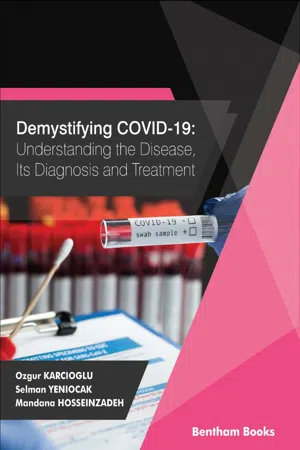
Demystifying COVID-19: Understanding the Disease, Its Diagnosis. and Treatment
- English
- ePUB (mobile friendly)
- Available on iOS & Android
Demystifying COVID-19: Understanding the Disease, Its Diagnosis. and Treatment
About This Book
The management of COVID-19 is challenging due to the lack of clear information about the Sars-Cov2 and recommendations for specific treatment regimens. The scale of the pandemic has also exacerbated the situation, with health care systems under stress from the high volume of COVID-19 patients.In Demystifying COVID-19: Understanding the Disease, Its Diagnosis, and Treatment, medical experts explain many aspects about the COVID-19 pandemic, including guidelines to minimize risk of infection, diagnostic methods, treatment, real scenarios in the course of the disease and issues that need attention in specific patient groups. The book equips both general readers and healthcare professionals with key information required to understand COVID-19 and navigate a situation typical to a pandemic. Public health officials who wish to mobilize awareness campaigns for the benefit of the general public can also find value in the comprehensive information presented in this reference. Key Features: - 16 chapters covering several aspects of COVID-19 including risk management, clinical diagnosis and treatment, public health issues and vaccines- Unique Q&A format which presents easy-to-understand information for all types of readers- Presents basic clinical information- Provides information for the management of COVID-19 in special patients (patients with comorbidities, the elderly, newborns, children, and pregnant women)- Bibliographic References for further reading
Frequently asked questions
Information
Principles of Treatment
Ozgur KARCIOGLU
Abstract
Antivirals

The mechanism of action of favipiravir (T-705) against the virus. Favipiravir is incorporated into cells and transformed by host cells into favipiravir ibofuranosyl - 5 ′ - triphosphate (favipiravir - RTP). The triphosphate form, favipiravir-RTP, inhibits the activity of RNA-dependent RNA polymerase (RdRp) of RNA viruses. AO: Aldehyde oxidase; RMP: Ribosyl monophosphate
| I. Nucleotide Analogues |
|---|
| Favipiravir |
| Ribavirin |
| Remdesivir |
| Nafamostat |
| Nitazoxanide |
| Valipiravir |
| II. Neuraminidase inhibitors |
| Oseltamivir |
| Zanamivir |
| Peramivir |
| III. Lopinavir/ Ritonavir (Kaletra ® ) |
| IV. Umifenovir (Arbidol ®) |
Nucleotide Analogues (NA)
1. Favipiravir
| - | FPV SE | Oseltamivir, Umifenovir, Lopinavir/Ritonavir SE |
|---|---|---|
| Grade 1-4 SE | 28,2% | 28,4% |
| SE that necessitates discontinuation of the drug | 1,1% | 1,2% |
| Serious SE | 0,4% | 0,4% |
| Gastrointestinal SE | 8,7% | 11,5% |
| Hyperuricemia | 5,8% | 1,3% |
Table of contents
- Welcome
- Table of Content
- Title
- BENTHAM SCIENCE PUBLISHERS LTD.
- PREFACE
- Contagion of the Pandemics: The Situation in the World
- How Can a Country Defeat COVID-19? Value of R0, Rt and Re
- Comorbid Diseases and COVID-19: COPD, Smoking, Obesity, Diabetes, Cancer, and Kidney Failure
- Risks and Losses of Healthcare Workers in the Pandemic Era
- What Kind of Disease is this? Signs and Symptoms, Predictors of Clinical Course and Management
- Diagnosis of COVID-19: Which Tests To Do? Laboratory and Radiological Adjuncts To Recognition
- Cardiovascular Disease, Myocarditis, Infarctions, And COVID-19
- Gastrointestinal Signs and Symptoms in the Course of COVID-19
- Is Our Psychology Affected By the Pandemic? How?
- COVID-19 and Our Brain: What's New?
- COVID-19 Pneumonia and ARDS: The Real Killer?
- Pregnancy, COVID-19, and Children: Dangerous Trio?
- COVID-19 and The Elderly: Is It Different From The Young?
- Principles of Treatment
- Critical Care in COVID-19
- Principles of Vaccination: Will it be the Definitive Solution?